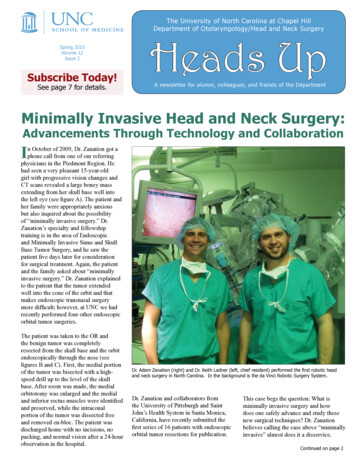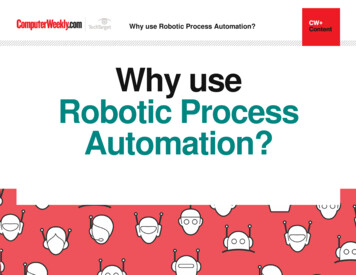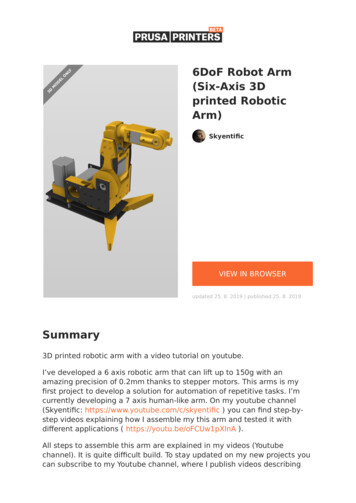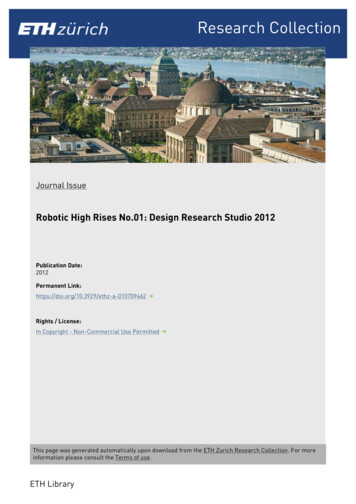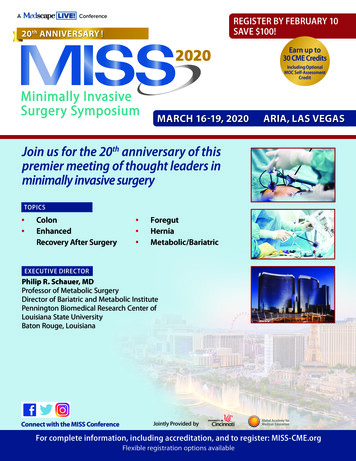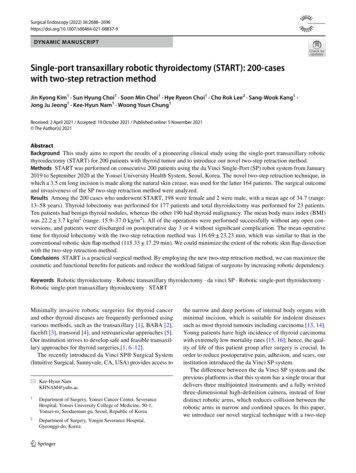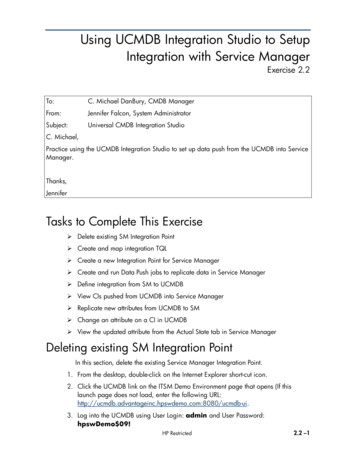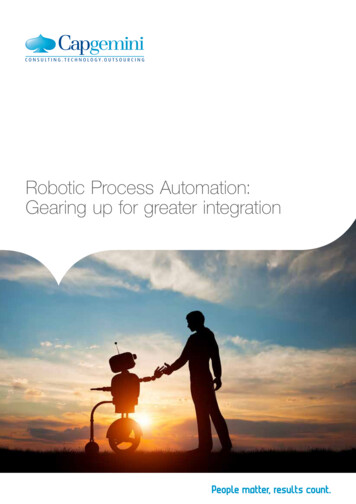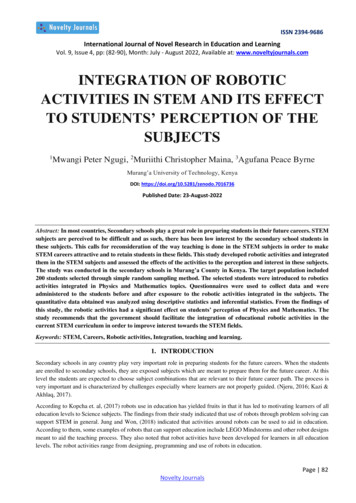
Transcription
ISSN 2394-9686International Journal of Novel Research in Education and LearningVol. 9, Issue 4, pp: (82-90), Month: July - August 2022, Available at: www.noveltyjournals.comINTEGRATION OF ROBOTICACTIVITIES IN STEM AND ITS EFFECTTO STUDENTS’ PERCEPTION OF THESUBJECTS1Mwangi Peter Ngugi, 2Muriithi Christopher Maina, 3Agufana Peace ByrneMurang’a University of Technology, KenyaDOI: https://doi.org/10.5281/zenodo.7016736Published Date: 23-August-2022Abstract: In most countries, Secondary schools play a great role in preparing students in their future careers. STEMsubjects are perceived to be difficult and as such, there has been low interest by the secondary school students inthese subjects. This calls for reconsideration of the way teaching is done in the STEM subjects in order to makeSTEM careers attractive and to retain students in these fields. This study developed robotic activities and integratedthem in the STEM subjects and assessed the effects of the activities to the perception and interest in these subjects.The study was conducted in the secondary schools in Murang’a County in Kenya. The target population included200 students selected through simple random sampling method. The selected students were introduced to roboticsactivities integrated in Physics and Mathematics topics. Questionnaires were used to collect data and wereadministered to the students before and after exposure to the robotic activities integrated in the subjects. Thequantitative data obtained was analyzed using descriptive statistics and inferential statistics. From the findings ofthis study, the robotic activities had a significant effect on students’ perception of Physics and Mathematics. Thestudy recommends that the government should facilitate the integration of educational robotic activities in thecurrent STEM curriculum in order to improve interest towards the STEM fields.Keywords: STEM, Careers, Robotic activities, Integration, teaching and learning.1. INTRODUCTIONSecondary schools in any country play very important role in preparing students for the future careers. When the studentsare enrolled to secondary schools, they are exposed subjects which are meant to prepare them for the future career. At thislevel the students are expected to choose subject combinations that are relevant to their future career path. The process isvery important and is characterized by challenges especially where learners are not properly guided. (Njeru, 2016; Kazi &Akhlaq, 2017).According to Kopcha et. al, (2017) robots use in education has yielded fruits in that it has led to motivating learners of alleducation levels to Science subjects. The findings from their study indicated that use of robots through problem solving cansupport STEM in general. Jung and Won, (2018) indicated that activities around robots can be used to aid in education.According to them, some examples of robots that can support education include LEGO Mindstorms and other robot designsmeant to aid the teaching process. They also noted that robot activities have been developed for learners in all educationlevels. The robot activities range from designing, programming and use of robots in education.Page 82Novelty Journals
ISSN 2394-9686International Journal of Novel Research in Education and LearningVol. 9, Issue 4, pp: (82-90), Month: July - August 2022, Available at: www.noveltyjournals.comScience, Technology, Engineering and Mathematics careers are vital in providing manpower to a growing economy therebyenhancing innovation and greater productivity (DeCoito, 2016). The students should go through the preparation processtowards the STEM careers which calls for new perspectives to be adopted by the schools to enhance the learningexperiences, work integrity and interest in related career (Carnevale, Smith & Melton, 2011). Research in STEM fields hasgrown immensely, with the priority of many researchers being contribution to the growth of the field, improvement in theSTEM workforce and to maintain more students the fields in post-secondary institutions. Furthermore, the students aretrained the STEM field in a way that they can compete in the global market (Heilbronner 2011). According to Sadler et al.,(2012) students are prepared for the STEM related career long before they join post-secondary levels of education. Thisagrees with the findings of Malin, Bragg and Hackmann (2017), who indicated that secondary school education preparesthe learners for the future career. The preparation process is complex, in that technology advances rapidly and thereforethere is need to ensure tomorrow’s job opportunities and the corresponding work force look different from todays(Hajkowicz et al., 2016).According to Mwangi et. al, (2022) robots employed in education have a great impact on the process of teaching andlearning of STEM subjects. They further indicated that the use of robot activities in learning of STEM subjects couldmotivate them to pursue STEM related careers. The use of these activities had greater impact in the primary school levelsas compared to other educational levels. They further noted that they could still be beneficial in higher educational levelswith some improvements. The study showed that the use of robots has a promising future for use in educational purposes.In this study the effect of integration of robotic activities to science subjects in secondary school is investigated2. LITERATURE REVIEWIntegration of developed robotic activities involves integrating concepts in different disciplines and expected learningoutcomes into a theme. Chen and Chang (2018) conducted a study on integrated robotics STEM course. The study adoptedthe use of a sailboat robot theme. Prior to integrating the developed activities in STEM, the authors developed a webapproach. The sailboat theme was chosen for the study since it was interdisciplinary requiring physics, mathematics andengineering concepts. Specifically, the sailboat robotic activities were integrated in teaching motion and force in Physics,trigonometry and functions in Mathematics and illustration and optimization in Engineering.Integration of sailboat robot as outlined in Chen and Chang (2018) involved 7 units. Under Unit 1, there was introductionon forces where different aspects such as frictional resistance, relationship between force and surface area were taught withstudents required to perform simulations, thus enhancing their understanding on manipulating sailboat movement. In Unit2, geometry and buoyancy were instructed. Unit 3 involved understanding the programing aspects so as to manipulate thesailboat into performing different academic tasks while Unit 4 involved instructions on input/output analysis in electronics.Unit 5 was basics on repairs and maintenance of the sailboat robot, where students were even allowed to tailor-make therobot and if possible launch their own-make. In Units 6 and 7, important engineering concepts were introduced such asoptimization, where optimal decisions were to be made such as cost decisions, stability among others.A study by Benitti and Spolaor (2017) involved a systematic review of 60 publications to evaluate concepts considered ineducational robots and how the robots are integrated in the school curriculum. Majority of the literature reviewed supporteduse of flexible robots to enhance integration across disciplines in the education curriculum. For Ching et al., (2019),integration of robotics in elementary schools’ curriculum should adopt a project-based learning (PBL) approach. The PBLapproach enables the structuring of the overall curriculum by giving the students opportunities to investigate authentic topicsor problems. In addition, students can engage in learning STEM related topics through active creation of artifacts withteachers acting as facilitators during the hands-on activities.In the United States of America, Ntemngwa and Oliver (2018) conducted a study on how robots would be integrated inSTEM instructions. The study was conducted using learners and teachers in Middle Level of education. LEGO MindstormsEV3 based robots were used in the study. During integration of different robotic activities in STEM subjects, the studyfound it necessary to restructure the STEM curriculum in themes so as to align it within the project of the robotics. Forinstance, in this case, different themes were created such as the “Body Forward” to integrate anything that was related tothe body systems of animals, “asteroid exploration theme” for teaching topics related to astronomy and scientific explorationof planets, “the color sorting project” whose aim was to teach topics related to optics, “acceleration theme” for LinearPage 83Novelty Journals
ISSN 2394-9686International Journal of Novel Research in Education and LearningVol. 9, Issue 4, pp: (82-90), Month: July - August 2022, Available at: www.noveltyjournals.comMotion amongst others. This way, teachers would simply fit simple instructions into an existing theme thus making it easierto implement educational robots in learning.Scaradozzi et al., (2015) suggested an innovative approach of teaching using robotics. The approach suggested was testedusing learners in a select Italian primary school. The study involved robots that ran on LEGO WeDo and LEGOMINDSTORMS NXT hardware and software. The robots were integrated in teaching Science and Mathematics topics. Thestudy found that robotics should be integrated in teaching Science and Mathematics in line with the school curriculum soas to witness an upgrade in learning of the subjects. While integrating the robotic activities in Science and Mathematics, theaim should be to expose learners to hands-on opportunities that engage them in applying the knowledge and skills they havelearned across disciplines.Mwangi et.al, (2022) developed robot activities and investigated how they could aid c learners understanding abstractconcepts in STEM and concluded they were indeed very effective. They noted that use activities developed around robotsmade learning fun, and interesting. It was noted that teaching and learning of STEM was more effective with improvedparticipation of learners.In Canada, Khanlari and Mansourkiaie (2015) evaluated the perceptions of teachers on using educational robots in STEMeducation. One research questions involved teachers providing sample topics in primary/elementary STEM subjects thatwould be easily taught using robotics. This was after the participants were exposed to functional robots that used hardwareand software of LEGO MINDSTORM. From the findings, it was evident that the teachers indicated that robots can be usedin teaching some Mathematics topics such as geometry, multiplication, addition, subtraction, division, measurement, shapes,orientation and movement of bodies. Teachers also stated that science topics such as circuits, force, motion, force, matterand structures.3. METHODOLOGY3.1 Integration of Robotic Activities.Some studies have been done investigating the implementation of integrated STEM lessons within courses that have a singlesubject science focus. Ntengwa and Oliver (2018) examined and generated an account of the implementation processes. Intheir study qualitative data was collected from interviews. The researcher adopted both quantitative and qualitative methodsof data collection in the integration of the robotic activities to Physics and mathematics.The block diagram on the process of integration of the robotic activities is shown in Figure 3.1.Developing roboticactivities related toselected topics inSTEMAnalysis andinterpretation ofdataDivision of theactivities intosmaller tasksAssessing the effect ofthe activities throughquestionnairesIntegration ofthe tasks STEMsubjects TopicsImplementation ofthe integratedactivities through aworkshopSource: Researcher (2021)Figure 3.1: Blockchain Diagram on Integration of the Educational Robotic ActivitiesIn this study, robotic activities were developed from a robotic car and a robotic arm designed by the researcher. The activitieswere broken into smaller tasks for purposes of integration. The tasks were then integrated into STEM subjects’learnt by thePage 84Novelty Journals
ISSN 2394-9686International Journal of Novel Research in Education and LearningVol. 9, Issue 4, pp: (82-90), Month: July - August 2022, Available at: www.noveltyjournals.comstudents in class. In this study Physics and mathematics were the subjects selected. The main focus of the robotic activitieswas to relate the robotics with Physics and Mathematics. The integration included general topics in physics like electricityand electronics.The emphasis on the practical aspects included building electrical circuits, assembling different. The educational roboticactivities developed were applied in teaching some concepts like kinematics and dynamics which were studied through themovement and interaction of the robot with the environment. The other set concept that were learnt are in modern physicslike the photoelectric effect that governs the operation of the light sensors (phototransistors) which were easier to explainand provided an avenue of describing the propagation of electromagnetic waves. The ultrasonic sensors used andprogrammed in the robot, similarly allowed the students to learn about the dispersion of sound waves. The activities werealso integrated in topics such as forces, Linear and circular motion. In Mathematics the educational robots were integratedin topics like geometry, Linear motion, Trigonometry, Area and Perimeter among others.After this consideration, a workshop on Educational Robotics was conducted, which included developing robots andprogramming different parts of robotic arm and car.3.2 Effect of the integrated robotic activitiesIn order to establish the effect of integrating the robotic activities, the learners filled a questionnaire with items assessingthe effect of the robots in understanding, creativity and interest. The questionnaires were administered before and afterexposure to the integrated robotic activities.In the first session the learners were taken through basic programming of the robots, using the designed robotic car. Theymoved the car forward and backwards in linear motion at constant speed, acceleration or deceleration. The students learntto program their robot to move forward and backward in linear motion using the Arduino Uno programming environment.In the 2nd session, the main focus was physics where the students were reminded the basics of motion at constant speedand were asked to program their robot to move forward and then backward at constant speed. They were instructed toassemble an ultrasonic sensor on their robot in order to detect the distance from a stable object. They also assembled andprogrammed infra-red sensors on the robotic car in order to detect a black path drawn on some wooden boards. In thissession, the students were also reminded on the concept of acceleration, deceleration, circumference and perimeter ofparticular shape.In the 3rd session Mathematics activities took the Centre stage. The students were guided on the process of assembling therobotic arm. The arm was used to illustrate various concepts in Mathematics. These include; Geometry, Angles, Circularmotion, Rotation, Translation, Forces and Energy among others.4. RESULTS AND DISCUSSION4.1 Integration of Robotic Activities to Physics and Mathematics TopicsIn this study, the developed activities were integrated with the subjects’ students learn in class. Using the robot carmovement and the robotic arm rotation, several topics such as force, Light and sound, Linear and circular motion, Basicconcepts of electricity, Geometry and friction were discussed. The integration process involved including the developedactivities to be part of the hands-on activities to aid in learning topics in Physics and Mathematics as part of the curriculum.Therefore, themes were developed based on the nature of the activities and the topics in which the activities could beintegrated. The integration process was done based on four themes which included;i. Interdisciplinary nature of the activitiesii. Adaptability of the activities to educational settingsiii. Interest and participation in Classroom activitiesiv. Problem solvingThe Four themes and the corresponding activities integrated into various topics in this study are demonstrated in table 1.Page 85Novelty Journals
ISSN 2394-9686International Journal of Novel Research in Education and LearningVol. 9, Issue 4, pp: (82-90), Month: July - August 2022, Available at: www.noveltyjournals.comTable 1: Themes in Integration of Robotic Activities in Physics and MathematicsThemeInterdisciplinary nature of the activities Adaptability of the activities to educational settings Interest and participation in Classroom activities. Individual and group problem Solving Activities for integrationTechnical drawing activities. Drawing of basicshapes 2D and 3DLine following activitiesBasic programming activitiesObstacle avoidance robot activities.Robotic arm rotational dynamics activities.Basic electronics activitiesBasic programming.Robot part identification and assemblyLine and Obstacle following robot activities.Robotic arm rotational dynamics activities.Basic electronics activitiesBasic programming.Robot part identification and assemblyLine following robot activities.Obstacle avoidance robot activities.Robotic arm rotational dynamics activities.Basic electronics activitiesRobot part identification and assemblyLine and obstacle following robot activities.Robotic arm rotational dynamics activities.RemarksThe activities involved the twosubjectsThe activities were adaptable inteaching the Physics andMathematics topics indicatedThe activities improved learnersinterest during lessons in thetopics integrated with theactivities.The activities were implementedin groups and as such it improvedlearners’ ability to work in teams.4.2 The effect of Integration of robotic activities to learning of STEM subjects.In order to assess whether the integration of the developed activities to Physics and Mathematics topics had an effect onstudents’ perception towards the subjects, the researcher formed the basis of seeking opinion from the students. The studentswere therefore presented with questionnaire items that assessed how the integrated activities aided in understanding ofPhysics and Mathematics, made learning of Physics and mathematics fun, enhanced creativity, interest & motivation andhow the integrated activities made Physics and Mathematics easier. The students were presented with these items prior andafter exposure to the educational robot. The pretest responses findings are reported herein.On a Likert scale of Strongly Disagree to Strongly Agree, the participants were presented with several statements regardingrobotic activities and integration in Physics and Mathematics. The findings are as presented in Table 2.Table 2: Pretest Results Integration of Activities and Students’ Perception of Physics and MathematicsStronglyDisagreeThe use of robotic activities in learning various topicsin Physics and Mathematics can aid in understanding6 (3.1%)the sciencesThe use of the robotic activities can make learning of3 (1.6%)Physics and Mathematics funThe use of the robotic activities in learning of Physics0 (0.0%)and Mathematics can improve my creativityIntegration of robots in educational activities couldraise the interest of the students in participating in the16 (8.3%)classroom activitiesEducational robotics should be used as a learningobject to motivate student’s classroom instruction on12 (6.2%)Physics and Mathematics EducationEducational Robotics can aid in making learning of23 (12.0%)Physics and mathematics topics easierDisagreeNeither AgreeAgreenor DisagreeStronglyAgree5 (2.6%)35 (18.2%)102 (53.1%) 44 (22.9%)13 (6.8%)43 (22.4%)82 (42.7%) 51 (26.6%)7 (3.6%)36 (18.8%)86 (44.8%) 63 (32.8%)19 (9.9%)62 (32.3%)59 (30.7%) 36 (18.8%)23 (12.0%) 55 (28.6%)61 (31.8%) 41 (21.4%)27 (14.1%) 38 (19.8%)65 (33.9%) 39 (20.3%)Source: Research Data (2021)Page 86Novelty Journals
ISSN 2394-9686International Journal of Novel Research in Education and LearningVol. 9, Issue 4, pp: (82-90), Month: July - August 2022, Available at: www.noveltyjournals.comTable 1shows that 53.1% (102), 22.9% (44), 18.2% (35), 3.1% (6) and 2.6% (5) of the participants indicated that theyagreed, strongly agreed, neither agreed nor disagreed, strongly disagreed and disagreed respectively that the use of roboticactivities in learning various topics in Physics and Mathematics aid in understanding the sciences. The statement “The useof the robotic activities made learning of Physics and Mathematics fun” had 42.7% (82), 26.6% (51), 22.4% (43), 6.8% (13)and 1.6% (3) of the students agree, strongly agree, neither agree nor disagree, disagree and strongly disagree. Table 4.6 alsoshows that 44.8% (86) and 32.8% (63) of the students agreed and strongly agreed that the use of robotic activities in learningof Physics and Mathematics improved their creativity; 18.8% (36) neither agreed nor disagreed and 3.6% (7) disagreed.In total, 49.5% (95) of the respondents agreed and strongly agreed that integration of robots in educational activities couldraise the interest of the students in participating in the classroom activities; 32.3% (62) neither agreed nor disagreed, 9.9%(19) disagreed and 8.3% (16) strongly disagreed. Also evident from the findings is that 31.8% (61) and 21.4% (41) of therespondents agreed and strongly agreed that educational robotics should be used as a learning object to motivate students’classroom instruction on Physics and Mathematics education; 28.6% (55) neither agreed nor disagreed, 12.0% (23)disagreed and 6.2% (12) strongly disagreed. The findings also showed that 54.2% (104) of the respondents agreed andstrongly agreed that educational robotics aid in making learning of Physics and Mathematics topics easier.After being exposed to the educational robot, and working with the robots on their own, the students were presented withthe same questionnaire items. The Likert scale responses on robotic activities and integration are as presented in Table 3.Table 3: Post-test Results Integration of Activities and Students’ Perception of Physics and MathematicsStronglyDisagreeThe use of robotic activities in learning varioustopics in physics and mathematics aided in3 (1.6%)understanding the sciencesThe use of the robotic activities made learning of3 (1.6%)physics and mathematics funThe use of the robotic activities in learning of6 (3.1%)physics and mathematics improved my creativityIntegration of robots in educational activities raisedthe interest of the students in participating in the4 (2.1%)classroom activitiesEducational robotics should be used as a learningobject to motivate student’s classroom instruction on8 (4.2%)Physics and Mathematics EducationEducational Robotics aid in making learning of5 (2.6%)Physics and mathematics topics easierDisagreeNeither AgreeAgreenor DisagreeStronglyAgree4 (2.1%)5 (2.6%)90 (46.9%) 90 (46.9%)0 (0.0%)13 (6.8%)82 (42.7%) 94 (49.0%)2 (1.0%)9 (4.7%)76 (39.6%) 99 (51.6%)4 (2.1%)52 (27.1%)83 (43.2%) 49 (25.5%)12 (6.2%)39 (20.3%)66 (34.4%) 67 (34.9%)5 (2.6%)29 (15.1%)66 (34.4%) 87 (45.3%)Source: Research Data (2021)From the findings, 46.9% (90), another 46.9% (90), 2.6% (5), 2.1% (4) and 1.6% (3) of the respondents strongly agreed,agreed, neither agreed nor disagreed, disagreed and strongly disagreed respectively that the use of robotic activities inlearning various topics in Physics and Mathematics aid in understanding the sciences. From the findings, it is evident that49.0% (94), 42.7% (82), 6.8% (13) and 1.6% (3) of the respondents strongly agreed, agreed, neither agreed nor disagreedand strongly disagreed respectively that the use of robotic activities made learning of Physics and Mathematics fun. It isalso clear that 51.6% (99) of the participants strongly agreed that the use of robotic activities in learning of Physics andMathematics improved their creativity; 39.6% (76) agreed, 4.7% (9) neither agreed nor disagreed, 3.1% (6) stronglydisagreed and 1.0% (2) disagreed.The findings also showed that a total of 68.7% (132) of the respondents agreed and strongly agreed that integration of robotsin educational activities could raise the interest of the students in participating in the classroom activities; 27.1% (52) neitheragreed nor disagreed, 2.1% (4) disagreed and another 2.1% (4) strongly disagreed. The results also showed that 69.3% (133)of the respondents agreed and strongly agreed that educational robotics should be used as a learning object to motivatestudents’ classroom instruction on Physics and Mathematics education; 20.3% (39) neither agreed nor disagreed, 6.2% (12)disagreed and 4.2% (8) strongly disagreed. From the results, it is also evident that 45.3% (87), 34.4% (66), 15.1% (29),Page 87Novelty Journals
ISSN 2394-9686International Journal of Novel Research in Education and LearningVol. 9, Issue 4, pp: (82-90), Month: July - August 2022, Available at: www.noveltyjournals.com2.6% (5) and 2.6% (5) of the participants strongly agreed, agreed, neither agreed nor disagreed, disagreed and stronglydisagreed respectively that educational robotics aid in making learning of Physics and Mathematics easier.General observation of the pretest and posttest results reveal differences in responses on questionnaire items regarding thethemes developed. Through a paired sample t-test, the difference in the responses was assessed. First, the variables (items)under the ‘robotic activities and integration’ were compressed into one pretest variable, pre robotic activities integration,and one posttest variable, post robotic activities integration, through the use of the mean for the 5 items in this section.Paired sample t-test was then conducted. The null hypothesis tested was:From the paired sample statistics, the mean for the pretest responses is lower, pretest mean 3.9708, as compared to themean for the posttest responses, posttest mean 4.4094 (see Table 4).Table 4: Means on Pre-Robotic and Post-Robotic Integration of ActivitiesMeanPair 1Pre-robotic activities integration 3.9708Post-robotic activities integration 4.4094NStd. DeviationStd. Error Mean192192.64685.61950.04668.04471Source: Research Data (2021)The paired samples test shows that the p-value 0.0001 (see Table 5).It can therefore be concluded that the two means are significantly different. The fact that the posttest mean is greater is aclear indication that the themes developed during robotic activities integration in teaching Physics and Mathematicssignificantly improved students’ perception on understanding, fun, creativity, motivation and interest as a result of robotsin learning Physics and Mathematics.Table 5: Paired Sample t-test on Pre-Robotic and Post-Robotic Activities IntegrationPaired DifferencesMean Std.DeviationPair 1Pre-robotic activitiesintegration – post- .88476roboticactivities .43854integrationTDfStd. Error 95% Confidence IntervalMeanof the DifferenceLowerUpper.06385-.56449-.31260-6.868 191Sig. (2tailed).000Source: Research Data (2021)5. CONCLUSION AND RECOMMENDATION5.1 ConclusionFrom the research finding it can be concluded thati. The use of robotic activities in learning various topics in physics and mathematics can aid in in the learning of STEMsubjects by making the learning of the subjects’ fun.ii. Learning through the integrated robotic activities improved learners’ creativity and also enhanced their ability to solvedifficult STEM problems. This agrees with findings of Afari, E., & Khine, M. S., (2017)iii. Integration of robots through educational activities raised the interest of the students in participating in the classroomactivities and consequently improved their interest in STEM subjects which agrees with the findings of Ben-BassatLevy, R., & Ben-Ari, M. (2017, April).iv. Educational robotics should be used as a learning tools in order to motivate student’s classroom instruction on STEMsubjects in that they made teaching and learning of the subjects easier.v. That integration of robotic activities in Physics and Mathematics should be based on themes that enhance creativity,innovation and excite learners while being taught different topics.Page 88Novelty Journals
ISSN 2394-9686International Journal of Novel Research in Education and LearningVol. 9, Issue 4, pp: (82-90), Month: July - August 2022, Available at: www.noveltyjournals.com5.2 RecommendationsRobotic activities should be integrated in STEM subjects to promote teaching and learning of the subjects. This will requirethe government of any given country to facilitate the integration of the activities in the current STEM curriculum. Throughpolicy makers in education, the curriculum should be reviewed so as to adopt educational robots and integrated activities tobe utilized in the teaching and learning processREFERENCES[1] Afari, E., & Khine, M. S. (2017). Robotics as an educational tool: Impact of lego mindstorms. International Journalof Information and Education Technology, 7(6), 437-442.[2] Altin, H., & Pedaste, M. (2013). Learning approaches to applying robotics in science education. Journal of balticscience education, 12(3), 365.[3] Benitti, F. B. V., & Spolaôr, N. (2017). How have robots supported STEM teaching? In Robotics in STEMeducation (pp. 103-129). Springer, Cham.[4] Ben-Bassat Levy, R., & Ben-Ari, M. (2017, April). The evaluation of robotics activities for facilitating STEM learning.In International Conference on Robotics and Education RiE 2017 (pp. 132-137). Springer, Cham.[5] Bybee, R. W. (2010). Advancing STEM education: A 2020 vision. Technology and engineering teacher, 70(1), 30.[6] Carnevale, A. P., Smith, N., & Melton, M. (2011). STEM: ScienceMathematics. Georgetown University Center on Education and the Workforce.TechnologyEngineering[7] Chen, Y., & Chang, C. C. (2018
According to them, some examples of robots that can support education include LEGO Mindstorms and other robot designs meant to aid the teaching process. They also noted that robot activities have been developed for learners in all education levels. The robot activities range from designing, programming and use of robots in education.
